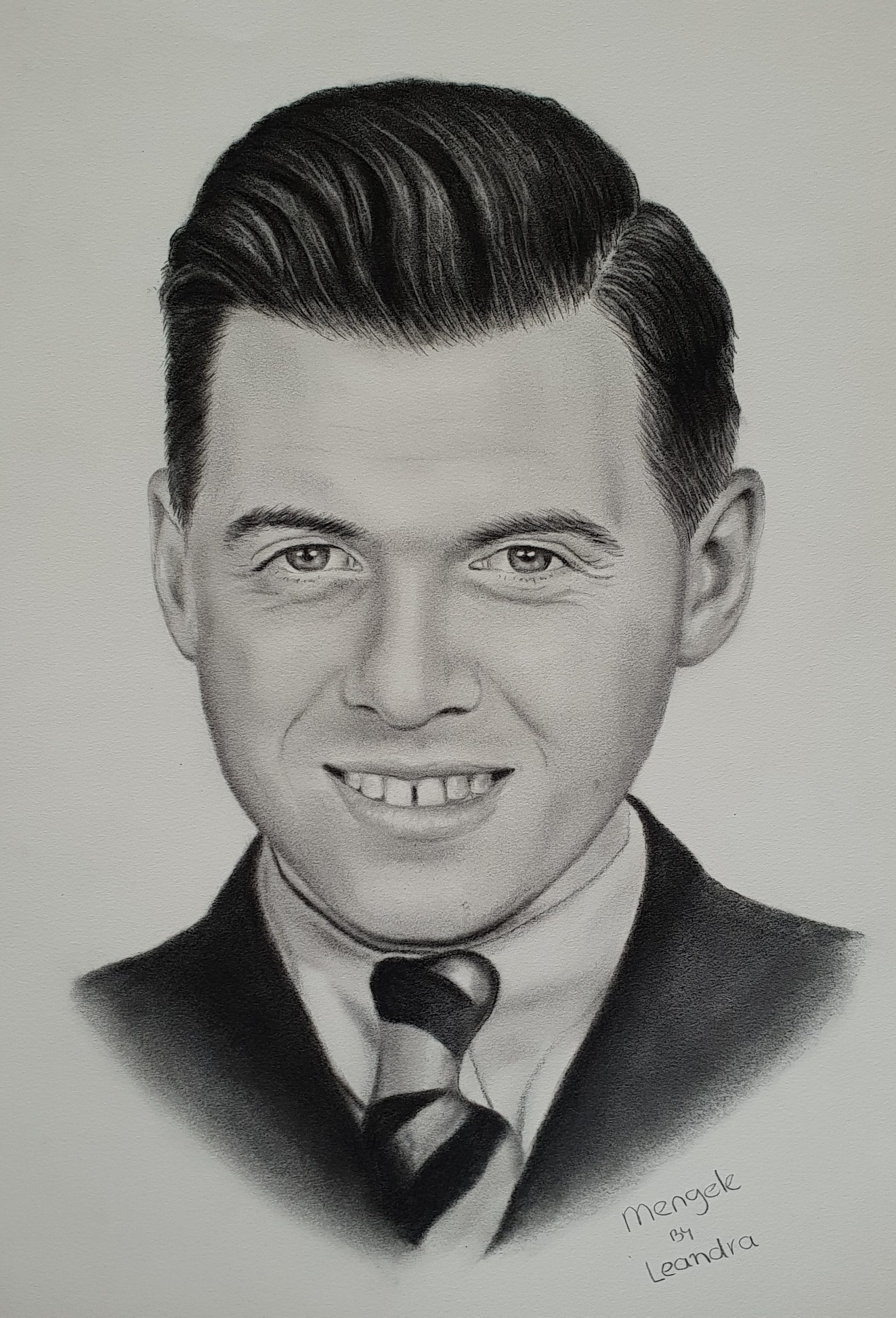Josef Mengele

SS-Hauptsturmführer Josef Mengele was born on 16 March 1911 in Günzburg, Germany. Mengele came from a wealthy Catholic family of Bavarian industrialists and agricultural machinery manufacturer Mengele Agrartechnik AG. He was ambitious as a student and wanted to become a professor and rise to scientific fame. From 1930 he studied medicine and medical anthropology in Munich, Vienna and Bonn. His fellow students described him as a popular and friendly man, who enjoyed life.
At the beginning of the 1930’s Mengele joined the organization Stahlhelm, which later merged into the SA. He withdrew from this in 1934, citing health reasons. In 1935 he obtained his PhD for the first time, in anthropology, on the thesis Racial morphological research of the anterior part of the lower jaw in four racial groups. In 1936 he took a medical examination and performed a four-month co-assistantship in pediatrics in Leipzig. In 1937 he became an assistant at the ‘Institut für Erbbiologie und Rassenhygiene’ in Frankfurt am Main and became a member of the NSDAP. From this time dates his association with Professor Othmar Freiherr von Verschuer, a leading National Socialist heredity researcher with good contacts in the SS. In 1938 he concluded his studies in medicine at the University of Frankfurt am Main with the thesis Family group research in lip-jaw-palate cleft. Also in 1938 he joined the SS. He performed his military service between September 1938 and January 1939.
In 1939 Mengele married Irene Schoenbein, who was born in 1920. She was a tall, blonde, good looking young woman and the daughter of an university professor from Leipzig. Together they had one son named Rolf, who was born on the same date as his father 33 years later, on 16 March 1944.
In 1940 Mengele was called up for the Wehrmacht and he volunteered for the Waffen-SS in August. In January 1942 he joined the medical corps of the Waffen SS’s Viking division. In July the Viking division moved up to the front to engage in the battle for Rostow and Bataisk, a battle lasting five bloody days. It was during this period Mengele won his Iron Cross First Class for rescuing two wounded soldiers out of a burning tank under enemy fire on the battlefield and gave them medical first aid. Later that year he was sent to Poland as a battalion doctor, where he was seriously wounded in 1942. After healing, he was no longer suitable for the front and was sent to Berlin.
From 30 May 1943 he worked in Auschwitz concentration camp as a doctor and was responsible for the selection of prisoners, where he decided if they would live or die. In contrast to most other SS men, Mengele could perform these selections without the use of alcohol or other stimulants. He owes his nickname “Angel of Death” largely to this position; the prisoners were selected by Mengele on arrival at the camp. Those who did not pass the selection were immediately forwarded to the gas chamber.
Mengele became infamous for his cruel medical experiments in Block 10 of Auschwitz, on prisoners and in particular twins, who by their genetic equality were considered important for eugenics. The experiments included exposure to cold until death followed, experiments in vacuum chambers, unnecessary amputation of limbs and removal of organs, reportedly often without anaesthesia, lumbar punctures, typhoid injections, intentionally infecting wounds and trying out medical treatments and drugs. One of his experiments aimed to create Siamese twins by sewing the identical twins, Tito and Nino, together by their backs and wrists. An experiment that failed because the sewed wounds got infected after a few days and they both died after suffering excruciating pain. Another experiment that failed was injecting blue dye into the eyes of the victims to make them “Aryan”. Deformed people, dwarfs, and other persons with anomalies shared the fate of the twins. Mengele fished them out of the stream of deportees at the ramp and had them thoroughly examined, killed, and dissected. During his time in Auschwitz, he supplied all kinds of human material to the Kaiser Wilhelm Institute for Anthropology, Human Genetics and Eugenics in Berlin and its director, Von Verschuer.
According to Auschwitz concentration camp survivors, Mengele’s personal acts of cruelty were usually provoked by fits of wild and uncontrollable temper. Dr. Gisella Perl, who worked under Mengele as a prison doctor in Birkenau, recalled an incident where a woman prisoner named Ibi was found by Mengele after she had escaped the gas chamber selections for six times. She somehow managed to gather enough strength each time to jump off the truck taking the victims to their deaths. Mengele was screaming at her while beating her head over and over again with his bare hands to a bloody pulp. Her ears seem to be torn off and her nose was a flat, broken, bleeding mass. He stopped when there was nothing left but a unrecognizable blood-red object on her bony shoulders and pushed her back into line. Half an hour later, Mengele returned to the hospital, took a piece of perfumed soap, whistling gaily with a smile of deep satisfaction on his face and began to wash his hands.
Mengele was described by many as an ambitious and intellectual workaholic, but he was also stubborn, smug, unpredictable, hot-headed, ruthless, narcissistic and incredibly self-centred. Since childhood he had been self-conscious about his slightly tawny skin, dark brown hair and brown-green eyes, because classmates taunt him with his Gypsy looks. In Bavaria where he grew up, the word “Gypsy” had a derogatory meaning denoting an unstable and unsettled person. Another part of his body he disliked was his distinctive forehead and eyebrows. Especially after the war this frustrated him a lot because he was afraid of recognition. Mengele had a big gap between his front teeth and he was not very tall by German standards with a height of 1,74 cm. He had a slim build and was a chain-smoker. Some Auschwitz survivors described him as a handsome man who looked like a movie star. Mengele usually wore white gloves and he had a fear of contamination, he washed his hands many times a day.
Mengele was also described as someone who was very vain. This once worked in his advantage. When the WWII came to an end he was captured by the allies who searched the arms of the captured soldiers for the blood group tattoo that most of the Waffen-SS members had on the inside upper arm. The purpose of the tattoo was to identify a soldier’s blood type in case a blood transfusion was needed while unconsious. Mengele did not had this tattoo because he was to vain to be ‘marked’. Luckily for him there where other men called Josef Mengele with German citizenship, and because there where not yet charges against him, he was soon to be released.
After the war, Mengele worked under a false name between 1945 and 1949 as a farmhand in Mangolding, a village near Rosenheim. In 1949 he escaped via Italy to South America. Between 1949 and 1959 he lived in Buenos Aires, financially supported by his family. In 1954 he divorced Irene. In 1956, he spent a vacation in Switzerland with the widow of his brother Karl, his German-born only son and a nephew. He applied for a new German passport under his own name and received it. He remarried in 1958 in Montevideo, the capital of Uruguay, to his sister-in-law Martha Maria Weil, born in 1920, Karl’s widow. Possibly so that the money she inherited after Karl’s death stayed in the Mengele family. In 1957, Mengele, who worked in Buenos Aires as a doctor in illegal abortion clinics, was arrested by the Argentine police on charges of having a hundredfold abortion and allowing a young woman to die during an abortion.
On 3 August 1958, the German writer Ernst Schnabel filed a complaint against Mengele. In February 1959 this led to a first arrest warrant. Mengele fled to Hohenau in Paraguay and became a Paraguayan citizen. After the kidnapping of Adolf Eichmann by the Israeli secret service, he no longer felt safe there in the summer of 1960 and went into hiding in Brazil.
His son Rolf says he visited him in ones 1956 and a second and last time in 1977.
Mengele died in 1979 while swimming, possibly from a heart attack or stroke. He was buried under the name ‘Wolfgang Gerhard’. His death remained a secret for a number of years. At the time, large sums of money were offered for his arrest. His identity was confirmed in 1985 after excavation of the body and measurement of the bones and definitively proven in 1992 when his DNA was compared with that of living relatives.
Family members refused repeated requests from Brazilian officials to repatriate the remains to Germany. The skeleton is stored in the São Paulo Institute of Forensic Medicine, where it is used as an educational tool during forensic medicine courses at the Medical Faculty of the University of São Paulo.
During his time in hiding in Paraguay and Brazil between 1960 and 1975, the former camp doctor wrote 3500 pages in spiral-bound school writing books. These writings include diary elements, philosophical musings, quotes from conversations, and political commentary. Some of the medical experiments on prisoners are described in it. These diary entries show that Mengele did not regret his actions and, like Eichmann, remained a convinced National Socialist without a sense of guilt until his death. He also defended the theory of The Other Varieties. In his writings, the doctor motivated the proposition that people with wrong genes should be sterilized. Mengele toyed with the idea of returning to Germany from 1972 and wondered what the situation was with his heimat, even more so: “Is she still my heimat and will Germany not treat me as an enemy”.
Although Mengele lived the rest of his live in freedom after the war, he did not experienced the feeling of being a free man. He was constantly in a hiding place, always dependent on people who helped him escape justice, knowing authorities were looking for him and could arrest him any day. He could never walk around his hiding places freely or go to other places to enjoy his life. It would be a small consolation for his victims, but in his diary he wrote that he was depressed, had suicidal thoughts and that he lived in fear everyday of being captured, after which he would be put on trial and probably be hanged like most other high ranked Nazi’s. Maybe and hopefully living a life in constant fear is far more worse than being killed instantly, or in some cases within minutes, with a noose around the neck.
Sources: Mengele The Complete Story by Gerald L. Posner and John Ware / People in Auschwitz by Hermann Langbein / I Was a Doctor in Auschwitz by Gisella Perl / Wikipedia
